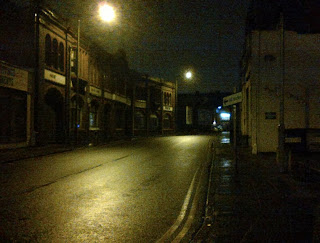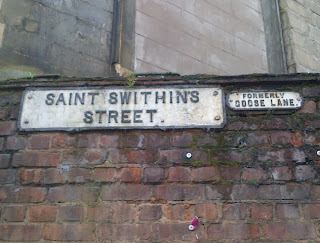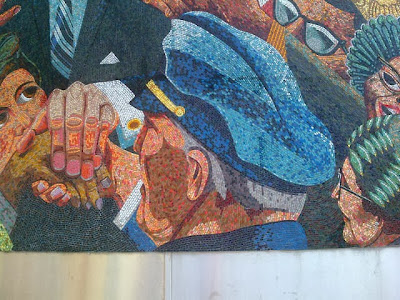Perhaps I'd better start this post by at least talking about what night means, & what it may mean to the various entities we may mean on our travels through a city. It is important not to forget the complete upheaval to human life that was caused by the Industrial Revolution, which is what marks the dividing line between the modern world in a form we would recognise, & the pre-industrial world so beloved of some pagans. I've heard a rumour that there's a joke in the saying about country people getting up with the cows & going to bed with the chickens (it may even be the other way round), but that is how people live if they don't have reliable light out of hours & are not shoehorned into the regular hours demanded by contractual employment.
Of course there is the huge divide in the English language of whether you call your evening meal tea or dinner; personally I come down on the side of calling it tea if it's earlier & dinner if it's later. I'm not overly attached to this distinction & it only appears here because eating later in the evening is a newish post-Industrial Revolution thing. The point of this is that in the past couple of hundred years a major disjoint in the way people live has occurred.
Cities, of course, always existed, but they have not been unaffected by the changes wrought by time, & often a relatively short period of time has marked the change. For example on the west side of Birmingham, as recently as the beginning of the nineteenth century the Hagley Road was open fields & Bearwood was a literal wood. So the spirits of a city may actually be terribly confused by the things that have happened, & night in the city, as with the evening meal, may happen at different times for different beings, & I don't just mean the ones who stay up clubbing all night.
I've actually been beating the streets of Birmingham for a long time; when you do that the spirit of a city looks at you & interacts with you in a different way from if you're just visiting. It remains that the best time to contact the spirit(s) of a place in detail is at night, define it as you will. Common sense precautions are of course necessary against some incarnate spirits, but I do think it's true that creatures of the night see a witch & even if they don't know what you are, recognise trouble staring them in the face.
This evening I started off in the markets, wandered towards the source of the Rea, passed the coach station, did some Digbeth back streets, wandered on Fazeley Street a little & went back into the city via Eastside. This is actually the older city centre than the present one, & is the setting for some major hot spots & energy centres. I like the feel of Digbeth, myself, it's straightforward, & I love the way you can turn a corner & come out into the old Birmingham.
Fazeley Street, on the other hand, freaks even me out at any time of the day or night. Today I had a distinct impression of being watched, & by some entity that definitely didn't want me to be there. From there up to, oh, Moor Street, I don't like the energies at all, except for one spot. I get this terrible sense of sadness there, & I don't think it's for nothing it's remained undeveloped until the city park opened. On the edge of the city park is what remains of the Park Street graveyard, which was opened as an overflow from St Martin's in 1807. It's really quite incongruent to be walking through a park & find a graveyard at the other end. Over Park Street is a wrecked pub I like, & that despite its appearance has been open since 2000.
I have to end with a picture to prove that Birmingham has some quaint street names. Paternoster Row dates from the 1870s, & was named after the Paternoster Row in London, since it had the same association with the printing industry. Of course it is not old enough to have the previous association of London's Paternoster Row, which was making rosaries - Paternoster is Latin for Our Father & refers to the beads to say the prayer on - & other Catholic tat. It is, however, friendly, despite that corner of the city being completely derelict if not actually flattened.
------------------





































